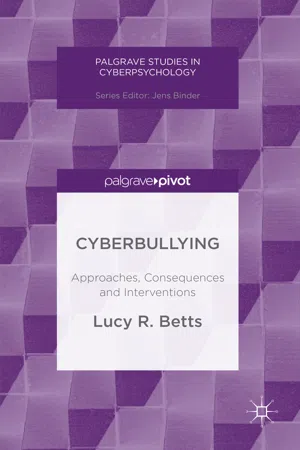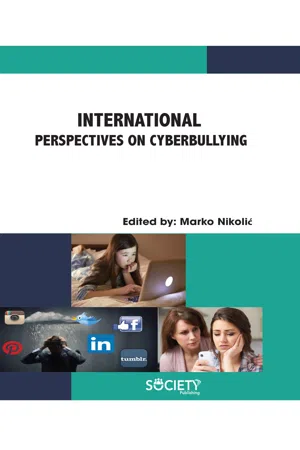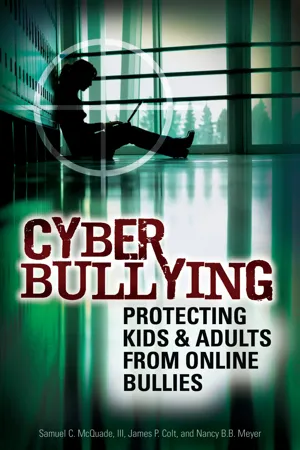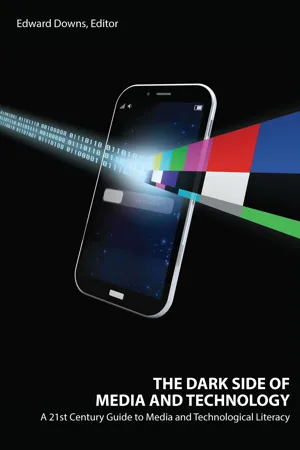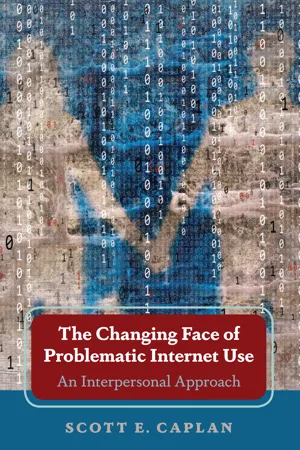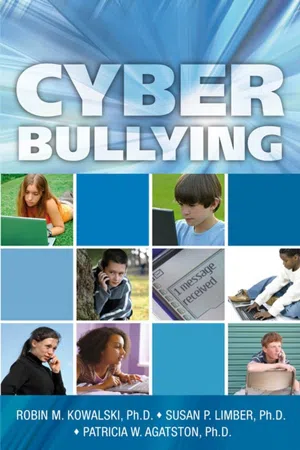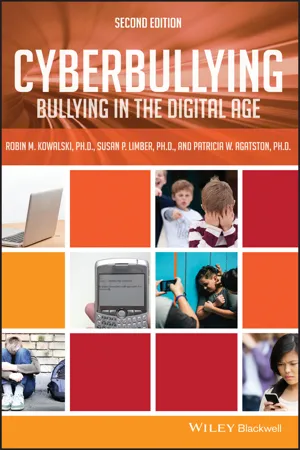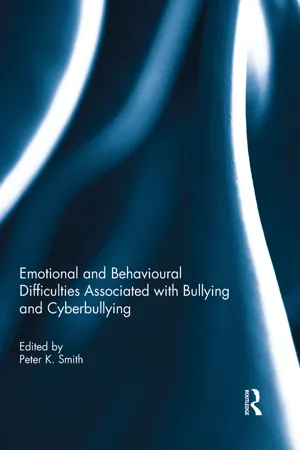Computer Science
Cyberbullying
Cyberbullying refers to the use of electronic communication to intimidate, harass, or harm others. This can occur through various digital platforms such as social media, messaging apps, or online forums. Cyberbullying can have serious psychological and emotional effects on the victims and is a growing concern in the digital age.
Written by Perlego with AI-assistance
Related key terms
1 of 5
11 Key excerpts on "Cyberbullying"
- eBook - ePub
Cyberbullying
Approaches, Consequences and Interventions
- Lucy R. Betts(Author)
- 2016(Publication Date)
- Palgrave Pivot(Publisher)
29). Cyberbullying involves ‘repeated use of technology to harass, humiliate, or threaten’ (Holladay, 2011, p. 4). ‘Cyberbullying is defined as the intentional act of online/digital intimidation, embarrassment, or harassment’ (Mark & Ratliffe, 2011, p. 92). Cyberbullying is ‘any peer-targeted aggressive behaviour via electronic communication technologies’ (Mehari et al., 2014, p. 400). Cyberbullying as ‘willful and repeated harm inflicted through the medium of electronic text’ (Patchin & Hinduja, 2006, p. 152). Cyberbullying is ‘repeated unwanted, hurtful, harassing, and/or threatening interaction through electronic communication media’ (Rafferty & Vander Ven, 2014, p. 364). Electronic bullying is ‘a means of bullying in which peers use electronics to taunt, insult, threaten, harass, and/or intimidate a peer’ (Raskauskas & Stoltz, 2007, p. 565). ‘Cyberbullying is a systematic abuse of power which occurs through the use of information and communication technologies (ICTs)’ (Slonje et al., 2013, p. 26). ‘Cyberbullying is any behavior performed through electronic or digital media by individuals or groups that repeatedly communicates hostile or aggressive messages intended to inflict harm or discomfort on others’ (Tokunaga, 2010, p. 278). ‘Cyberbullying occurs when Internet-based applications are used to systematically intimidate or insult a person so as to humiliate, embarrass, or hurt that person. Similar to offline bullying, Cyberbullying involves intentional repetitive actions and psychological violence’ (Valkenburg & Peter, 2011, pp. 124–125). Cyberbullying is ‘a form of aggression that occurs through personal computers (e.g., e-mail and instant messaging) or cell phones (e.g., text messaging)’ (Wang, Iannotti, & Nansel, 2009, p. 369). “When we say cyberbullied, we mean bullied through email, instant messaging, social media, in a chat room, on a website, in an online game, or through a text message sent to a cell phone - eBook - PDF
- Marko Nikolic(Author)
- 2019(Publication Date)
- Society Publishing(Publisher)
Despite the limitations and challenges International Perspectives on Cyberbullying 32 to impose traditional bullying criteria in a cyber setting, efforts to define Cyberbullying to date have largely centred on this approach. Finally, the way in which we label and define problematic cyber-based behaviour has real implications for protecting mental health. Due to the fact that there is potential for wide public access to online content, a single Cyberbullying incident could have a serious and lasting harmful effect on the victimised person. Therefore, refining the definition and conceptualisation of cyber-based aggression could have serious implications for protecting mental health, as no longer would a young person have to endure multiple episodes of victimization before the behaviour could be recognised as Cyberbullying. By removing the component of repetition from the conceptualisation of cyber aggression, we would be recognising the potential for one single act to cause psychological harm to a targeted person. HOW WE HAVE DEFINED Cyberbullying THUS FAR? Offering one of the earliest definitions, Belsey [21] defined Cyberbullying as “…the use of information and communication technologies to support deliberate, repeated, and hostile behaviour by an individual or group, that is intended to harm others”. Applying the existing criteria regarding traditional bullying, and alluding to the potential power imbalance, Smith and colleagues [22] later defined Cyberbullying as an “…aggressive intentional act carried out by a group or individual, using electronic forms of contact, repeatedly and over time against a victim who cannot easily defend him or herself” (p. 376). - eBook - PDF
Cyber Bullying
Protecting Kids and Adults from Online Bullies
- Samuel C. McQuade III, James P. Colt, Nancy Meyer(Authors)
- 2009(Publication Date)
- Praeger(Publisher)
DIGITAL TACTICS FOR TORMENTING OTHERS ONLINE As indicted earlier, we define cyber bullying as intentionally using comput- ers or other electronic devices to harass, threaten, intimidate, embarrass, or otherwise cause harm to another or others. Cyber bullying can be done in a number of ways, and can vary in degree of seriousness. As in the physical world, victims of cyber bullying can be harassed online about their physical appearance, social status, race, age, sex, gender, religion, academic perfor- mance, or disability. Victims are often youth, but adults such as teachers and school administrators have also reported being victims of cyber bullying by youth. In a recent survey of school building administrators from a large county in upstate New York, 32 percent of 107 administrators indicated that fac- ulty and staff in their school had been victims of cyber bullying. 4 In reality anyone can be bullied, threatened, or harassed online. The possibilities are endless, and the reasons and ways in which cyber bullying is taking place are constantly evolving. The bullying can take place through sending harassing e-mails and instant messages, or posting harmful material or images using the Internet or cellular phones. It can also be accomplished via social networking sites, blogs, and even through online gaming. Each method merits a little explanation with regard to how it is used to cyber bully. E-MAIL E-mails and instant messages have been considered a primary means in which cyber bullying takes place. Cyber bullying can be done through e-mail by the direct sending of annoying, cruel, insulting, or threatening messages to another. It can range in degree of seriousness from fairly benign (some- what annoying, cruel or insulting) to very serious (threatening, or extremely cruel). In addition, flame mail (provoking e-mails) and hate mail (hate speech directed at minorities or marginal groups) are other ways to electronically - eBook - PDF
- Mark Butlin, Noeleen McNamara, Kerrie Anglin(Authors)
- 2021(Publication Date)
- Cambridge University Press(Publisher)
consistent definition (Senate Legal and Constitutional Affairs Committee, 2018, rec- ommendation 1). In 2018 the Queensland Government commissioned an Anti- Cyberbullying Taskforce to address Cyberbullying among children and young people in Queensland. In arriving at a definition of Cyberbullying, the Taskforce recognised that it is a form of bullying behaviour. It defined it as follows (Department of the Premier and Cabinet Queensland, 2018, p. 4): Bullying is an ongoing misuse of power in relationships through usually repeated verbal, physical and/or social behaviour that is intended to cause physical and/or psychological harm. It can involve an individual or a group misusing their power over one or more people. Bullying can happen in person or using digital or other technologies, and it can be obvious (overt) or hidden (covert). Bullying of any form or for any reason can have long-term effects on those involved, including bystanders. Single incidents and conflict or fights between equals, whether in person or online, are not defined as bullying. The New South Wales Department of Education (2020c) has summarised bullying behaviour as having three key features: ‘it involves the intentional misuse of power in a relationship; it is ongoing and repeated; and it involves behaviours that can cause harm’. A 2018 Senate enquiry into the ‘Adequacy of existing offences in the Commonwealth Criminal Code and of state and territory criminal laws to capture Cyberbullying’ noted that the term is not static, with new technologies giving rise to new forms of Cyberbullying. - eBook - ePub
The Psychology of Criminal and Antisocial Behavior
Victim and Offender Perspectives
- Wayne Petherick, Grant Sinnamon(Authors)
- 2016(Publication Date)
- Academic Press(Publisher)
Online aggression came to the attention of researchers following a study of American students that was the first to identify Internet chat rooms and email as modalities for bullying. Since that time, another term was added to our lexicon for violent and antisocial behavior—Cyberbullying—and is now widely considered an emergent and significant problem. Thus far, literature has failed to agree on a universal definition for “Cyberbullying” and many definitions proffered refer directly back to traditional bullying and consider online aggression an extension of traditional bullying. The intentions of the current chapter authors are to contribute to the burgeoning amount of literature on this important area to discuss the importance of a consensus about the definition and conceptualization of online aggression, and to offer a workable and theoretically sound term that is appropriate and relevant to the generally accepted paradigm of Cyberbullying.Keywords
Assault; Bullying; Cyber; Cyberbullying; Harassment; Internet; Online; Online aggression; Recklessness; TelecommunicationsChapter OutlineIntroduction Background Reaching Consensus: The Importance of First Things First Relevance to Researchers Relevance to Research Participants Important for Detection, Intervention, and Treatment Cyberbullying? Online Aggression? Internet Harassment? It’s All in the Name Cyber, Online, or Internet? Bullying: Aggression or Harassment? Intent to Harm Repetition Provocation Imbalance of Power Aggression Harassment Conclusion Summary Questions ReferencesIntroduction
Until the seminal research conducted in the early 1990s by Dan Olweus (1993a , 1993b) , little was known about the perpetration and experience of bullying. In fact, rather than conceptualizing bullying behaviors as deliberate, harmful, and worthy of intervention, bullying was widely perceived as a rite of passage, a normal child-to-adolescent-to-adult developmental milestone, a behavior that one would “grow out of” or be erased from memory with the passage of time without consequence (Bradshaw, O’Brennan, & Sawyer, 2008 ; Campbell, 2000 ; Carr-Gregg & Manocha, 2011 - eBook - PDF
The Dark Side of Media and Technology
A 21st Century Guide to Media and Technological Literacy
- Edward Downs(Author)
- 2019(Publication Date)
Some of these forms are straightforward, whereas others can be complex. For example, impersonation occurs when a cy- berbully acts as the victim, by setting up a fake email address or phone number. One can imagine how a cyberbully might harm a victim by sending false or em- barrassing content to others. Further, Kaspersky, a global cybersecurity company, describes cyberstalking as a serious form of Cyberbullying where the cyberbully threatens a victim’s physical wellbeing or safety (see https://kids.kaspersky.com). Cyberstalking can also refer to when adults use the Internet to contact and at- tempt to meet with young people for sexual purposes. Denigration is a term to describe when cyberbullies send, post, or share rumors, gossip and falsehoods about a victim to humiliate the victim or damage their reputation or friendships. This is a common strategy in most Cyberbullying. Some cyberbullies may use hacking and exhibition of unapproved photos, videos, or other multimedia. Laws differ by state about what is illegal and what is not, and Cyberbullying cases are complex because a perpetrator can use any combination of these strategies to hurt victims. There may be different types of cyberbullies, but more research is needed in this area to be sure. For example, Aftab (2018) who hosts stopCyberbullying.org describes that cyberbullies can be one of four types known as vengeful angels, power hungry, mean girls, and inadvertent cyberbullies. Vengeful angels take justice into their own hands and enact Cyberbullying in an effort to intention- ally protect themselves or others. Although they may think they are doing the right thing, they are still engaging in Cyberbullying perpetration. Power hungry cyberbullies try to exert themselves over others, similar to a traditional bully, but online. Mean girls (who can also be mean boys) aim to entertain themselves by working as a team to embarrass or hurt victims. - eBook - PDF
The Changing Face of Problematic Internet Use
An Interpersonal Approach
- Scott E. Caplan(Author)
- 2018(Publication Date)
A review of the literature on Cyberbullying reveals that while there is considerable debate and disagreement about how to define cyberbul- lying, there are also areas where many researchers do agree. Scholars have demonstrated that using conceptual definitions of traditional bul- lying is a useful way to approach defining Cyberbullying. Here, Olweus’ (1993) three characteristics of traditional bullying (intentionality, repeti- tion, and power imbalance) have helped guide Cyberbullying research- ers in their efforts to characterize Cyberbullying. Exploring how Cyberbullying differs from traditional bullying has also been an essential part of the debate. Here, researchers have argued that Cyberbullying is a unique and distinct type of interpersonal aggres- sion due to the communicative characteristics of the online environ- ment. As noted in this chapter, Cyberbullying is distinct from traditional bullying due to the fact that, in Cyberbullying, the aggression may be quickly spread to a vast audience. And, in many cases, the harmful mate- rial cyberbullies send or post may persist online even after the initial 138 THE CHANGING FACE OF PROBLEMATIC INTERNET USE aggressive act has ended. These features of online technology also serve to create a power imbalance between the victim and bully—the bully can spread hurtful information quickly to a broad audience before the victim is even aware of what has happened. Moreover, the persistent nature of online material, along with the fact that such material is difficult to delete, further enhances the cyberbully’s power. The research presented in this chapter suggests that the reduced social presence afforded by interpersonal technologies may function to disinhibit cyberbullies, making it easier for them to aggress and reduc- ing potential feelings of guilt. - eBook - PDF
Cyber Bullying
Bullying in the Digital Age
- Robin M. Kowalski, Susan P. Limber, Patricia W. Agatston(Authors)
- 2008(Publication Date)
- Wiley-Blackwell(Publisher)
It further notes that: An act of harassment, intimidation or bullying may also be committed through the use of a land line, car phone or wireless telephone or through the use of data or computer software that is accessed through a computer, computer system, or computer network. Idaho legislators did not specify that such acts must occur on school equip-ment or on school grounds. The three remaining state laws addressing cyber bullying are more limit-ing in focusing on cyber bullying that takes place on school grounds or at school-sponsored events. Washington law (SB 5288, 2007) requires school districts to adopt policies prohibiting “harassment, intimidation, or bully-ing of any student.” The statute defines harassment, intimidation, or bul-lying as: laws and policies 163 any intentional electronic, written, verbal, or physical act, including but not limited to one shown to be motivated by any characteristic in RCW 9A.36.080(3), or other distinguishing characteristics, when the intentional electronic, written, verbal, or physical act: (a) Physically harms a student or damages the student’s property; or (b) Has the effect of substantially inter-fering with a student’s education; or (c) Is so severe, persistent, or pervasive that it creates an intimidating or threatening educational environment; or (d) Has the effect of substantially disrupting the orderly operation of the school. - eBook - ePub
Cyberbullying
Bullying in the Digital Age
- Robin M. Kowalski, Susan P. Limber, Patricia W. Agatston(Authors)
- 2012(Publication Date)
- Wiley-Blackwell(Publisher)
To this list, we would add those perpetrators who cyberbully others who are perceived to be different in some way (Hoff & Mitchell, 2009). The literature on traditional bullying is clear that children with disabilities, for example, are more likely to be bullied than their peers. Although little research has been conducted on the Cyberbullying experiences of children with disabilities, there is every reason to believe that they will be disproportionately targeted in the virtual world as they are in the real world (see Didden et al., 2009; Kowalski & Fedina, 2011).How Cyberbullying Differs from Other Types of BullyingA logical question for those interested in Cyberbullying is the extent to which it is similar to and different from traditional bullying. We believe Cyberbullying shares with traditional bullying the three primary characteristics of bullying that were discussed in Chapter 2: (a) the behavior is aggressive; (b) there is a power imbalance between the victim and the perpetrator; and (c) the behavior is repeated. Importantly, a power imbalance may be somewhat different in cyberspace than it is in a face-to-face interaction. Because of the nature of cyberspace (and particularly the anonymity it may present, something we will return to below), a child who might wield little power over a victim face-to-face may wield a great deal of power (and fear) in cyberspace. More specifically, there is power in being anonymous, in assuming a false identity, in having the ability to spread rumors and lies to a wide audience, and in being able to harass a victim anywhere and anytime (Dooley et al., 2009; Vandebosch & van Cleemput, 2008).Furthermore, although typically bullying is defined as not occurring once or twice, but as being a repeated behavior, the picture becomes a bit murky in cyberspace. A single act (e.g., a nasty e-mail or an inflammatory text message) may be forwarded to hundreds or thousands of children over a period of time. Think how easy it is to copy, paste, and share an inflammatory message. Note how quickly videos go viral. From a victim’s perspective, he or she may feel repeatedly bullied, to say nothing of the fact that the victim may reread the e-mail or text message himself or herself multiple times, again leading to the feeling of being bullied repeatedly. Even though there may have been only one initial act, it may have been perpetrated through many people and over time. - eBook - PDF
- Laura A. Wankel, Charles Wankel, Laura A. Wankel, Charles Wankel, Charles Wankel(Authors)
- 2012(Publication Date)
- Emerald Group Publishing Limited(Publisher)
As the current study links cyber bullying at work to various negative outcomes, this highlights the importance of formally addressing online etiquette at work to reduce the likelihood of outcomes such as burnout and negative employee emotions. As in Study 1, however, additional research is needed in this area, particularly using a larger sample size. Comparisons of the cyber bullying experiences of employed college students across different employment settings would also yield important information regarding the settings that seem most conducive to this type of behavior. GENERAL DISCUSSION The current chapter takes a step toward understanding cyber bullying as a form of misbehavior among college students and the reactions and outcomes that accompany this experience. Cyber bullying has traditionally been investigated as a middle school phenomenon, but the current studies demonstrate that it occurs with great frequency among college students as well. A significant portion of the college students in the current sample reported experiencing cyber bullying for the first time in college. This behavior occurred through a variety of media (including text messages, e-mails, Facebook posts, and chat rooms) across the general college student sample and the employed sample, indicating that cyber bullying is pervasive across different ICTs at school and at work. Faced with these aggressive encounters, the most common response for students in both samples was to do nothing about this behavior. This form of coping with cyber bullying may not be effective in the long term, as cyber bullies may continue to engage in this behavior without consequence, and victims may experience several negative outcomes. Several researchers have suggested that victims should speak up so that the bullies can be counseled and support can be given to victims ( Kowalski et al., 2012 ). - Peter Smith(Author)
- 2013(Publication Date)
- Routledge(Publisher)
From Cyberbullying to electronic aggression: typology of the phenomenon Jacek Pyżzalski Nofer Institute of Occupational Medicine, Lodz, PolandCyberbullying is usually operationalised as a kind of bullying understood as peer aggression that is intentional and continuous, and involves an aspect of imbalance of power between a victim and a perpetrator or perpetrators. Despite the tool used (new media), Cyberbullying often takes place within a traditional group (e.g. school class). However, cyberspace gives Internet users the opportunity to attack other individuals: people known only from the Internet, celebrities, teachers, totally unknown individuals or whole groups of people. Involvement in such actions brings suffering to those victimised as well as potential negative consequences for the perpetrators. This article presents a typology of electronic aggression based on qualitative research data (interviews with teachers and students). The typology was validated in a large quantitative survey on a representative sample of Polish 15-year-olds. The survey gives the prevalence of perpetration of different kinds of electronic aggression, as well as some influencing factors (e.g. gender) and risk and protective factors (attitudes towards school, peer norms, negative relations in the family, norms concerning online behaviour at school/home, pro-aggressive beliefs, level of self-esteem). The need to broaden prevention and intervention measures, and not restrict them to the issue of electronic peer aggression, is discussed.Introduction: new media as tools for aggression in young people
Modern communication technologies (the Internet and mobile phones) can be used as tools to conduct aggressive acts against other people. For those acts one can use an umbrella term ‘electronic aggression’, understood as any type of harassment or bullying, including teasing, telling lies, making fun of, making rude or mean comments, spreading rumours, or making threatening or aggressive comments, that occurs through email, a chatroom, instant messaging, a website or text messaging (David-Ferdon and Feldman Hertz 2007).
Index pages curate the most relevant extracts from our library of academic textbooks. They’ve been created using an in-house natural language model (NLM), each adding context and meaning to key research topics.
